Speech Current Issues for the Global Economy

Malcolm Edey
Assistant Governor (Economic)
Address to the Australia-Japan Economic Outlook Conference
Sydney –
It's a pleasure to speak again at this conference, and I thank the Japanese Consulate and Australia-Japan Economic Intelligence for the invitation.
When I spoke at this event just over a year ago, the major economies had entered a period of recovery, but it was still quite hesitant in nature. Some of the economic indicators at the time were starting to look less promising, and attention was focused on whether the momentum of the recovery was likely to be sustained. The view I expressed then was one of cautious optimism, to the effect that a continued gradual recovery looked the most likely prospect, despite the short-term weakness that seemed to be emerging at the time.
A year later those comments still seem to stand up reasonably well, but there have, of course, been some significant shifts in the economic situation in the intervening period. In my remarks today I will try and convey how the situation has developed over the year and look at what that might mean for prospects from here on.
The Current Business Cycle
Before getting into the latest numbers, let me begin with some general observations about the current business cycle and how it compares with previous ones. For the major industrial economies (represented here by the G7 countries) aggregate growth has clearly picked up off the trough that it reached in 2001, but it remains below its long-run average (Graph 1). By this stage, we have a fairly good estimate of growth in these countries in the current year, and this looks likely to be a bit under 2 per cent. This means that the current cycle to date can be characterised as having had three years of below-average performance in the major economies. That makes it a downturn of comparable size and duration to the one that occurred in the early 1990s, though noticeably less severe than the early 80s.
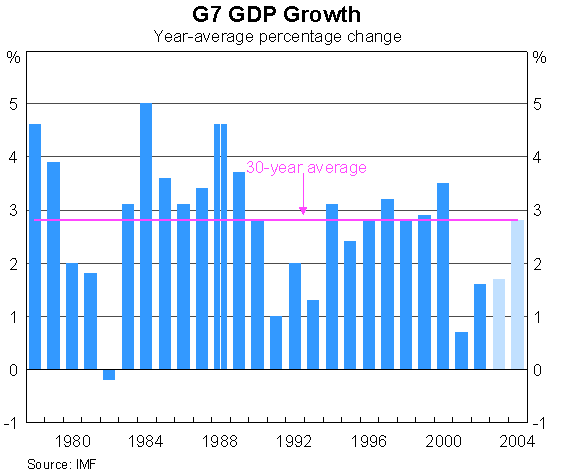
The International Monetary Fund (IMF) forecast is for this growth rate to pick up to 2¾ per cent, or around its long-run average, in 2004. It is important to note that, for the G7 economies in aggregate, this would imply that the period of below-par growth is now largely behind us. That is, the forecast implies a within-year pattern that has growth picking up noticeably in the second half of the current year.
Developments in the Year to Date
With that background, let me return to the question of how the global economic situation, and assessments about the outlook, have evolved over the recent period.
Throughout the year to date, a forecast something like the one I've just outlined, embodying a gradual return to trend growth in the major economies, would have been broadly endorsed by most observers. But there have, nevertheless, been some significant shifts in expectations as to the likely timing of the pick-up and, more importantly, in views about the balance of risks. Broadly speaking, this has evolved in two phases. In the first half of this year, the risks to the global economy appeared to shift quite noticeably to the downside. In contrast, information becoming available since around mid-year has generally been more positive. We can best review these developments by looking at the major regions of the global economy in turn.
As is usually the case, much of the attention has focused on developments in the US. In the early part of the year, incoming data showed a significant easing in the pace of growth, and we can see from the national accounts data here that GDP growth slowed quite noticeably at that time (Graph 2). Issues of concern were that employment was falling, profitability was still low, and there were signs that consumer spending was faltering, whereas previously it had been the main driver of growth. The weaker economic data raised concerns that the recovery may have been running out of steam, with growth still being held back by the after-effects of the equity price collapse. Added to all this was the uncertainty associated with the Iraq situation, which was weighing on business and consumer confidence. Despite all this, most observers still held to the view that this period of weakness would be relatively short-lived. But, for much of the first half of the year, the risk of a more protracted slowdown seemed to be increasing.
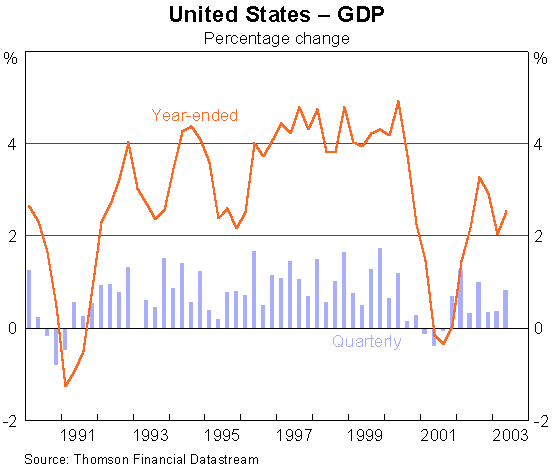
This situation has changed quite markedly since around mid-year. Generally the information that has become available since then has pointed to stronger than expected outcomes, and improved prospects for the second half of the year. One important piece of information was the second quarter national accounts, which showed stronger than expected growth in quarterly GDP. To round up some of the other more recent indicators:
- Consumer spending has resumed a good pace of growth, boosted by the recent tax cuts, after a pause in the early part of the year (Graph 3). This now looks to have contributed strongly to growth in the third quarter;
- Housing permits and starts have risen to record levels over recent months (Graph 4);
- Business sentiment has also improved markedly (Graph 5). Based on the ISM survey (Institute for Supply Management formerly NAPM – the National Association of Purchasing Managers) reported here, the manufacturing sector is performing more strongly, and sentiment among non-manufacturing businesses is at the highest levels seen over recent years.
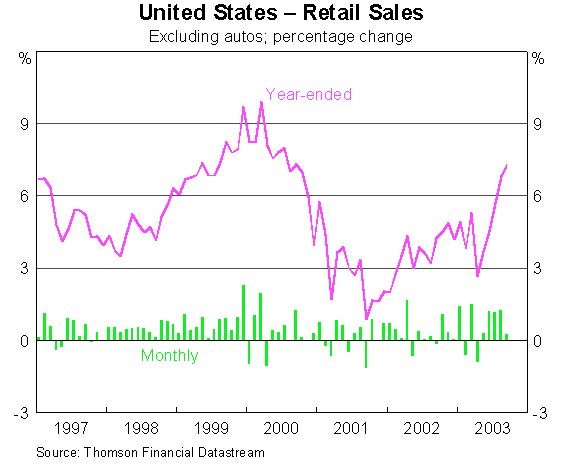
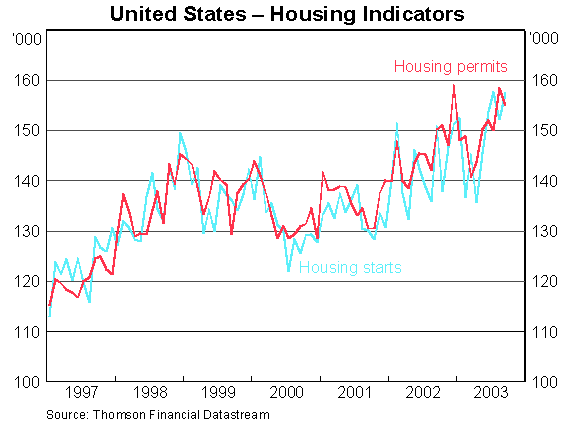
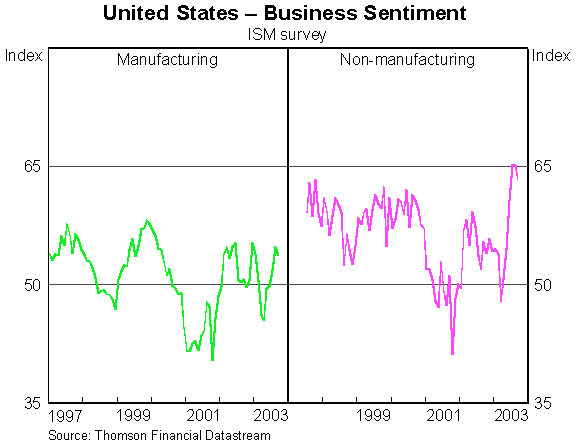
It is also interesting to look in more detail at the composition of growth in the US. For some time, consumer spending has been the mainstay of growth (Graph 6). In contrast, business investment fell sharply as the economy went into recession during 2001, and it remained a significant drag on growth for some time afterwards. This reflected lingering imbalances affecting the business sector, particularly low profitability and an overhang in capital in a number of areas, especially in IT equipment and in the telecommunications sector. There are signs now that these imbalances are starting to be wound back. Profits have picked up quite strongly in the past half-year and, as my previous slide indicated, business confidence has been improving. Investment now seems to have at least stopped falling, and in the latest quarter it posted a small increase. More recent indications of investment spending based on capital goods orders have also been gradually picking up. These trends, if they continue, seem to offer the prospect of a more balanced composition of growth as the recovery proceeds.
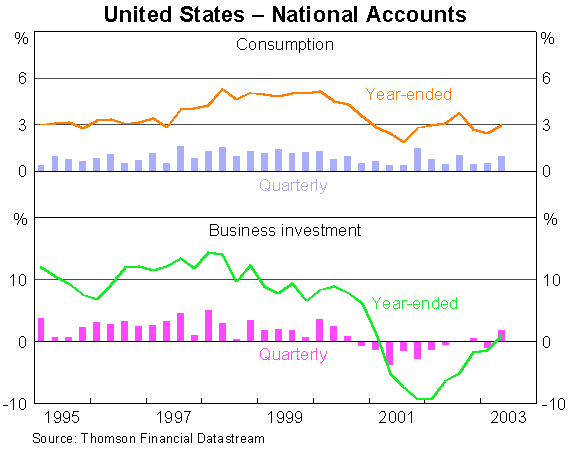
The main area where outcomes have still been disappointing has been the labour market. Despite reasonable growth in GDP, the level of employment so far this year has continued to drift lower, notwithstanding a small increase in the latest month. Obviously some pick-up in employment will be an important element if the recovery is to be sustained. For the present, though, drawing the various recent pieces of data together, most observers are expecting a solid outcome for GDP growth to be reported for the third quarter. All of this amounts to a noticeably more positive picture than was the case earlier in the year, when conditions had been deteriorating.
The other important part of the world economy to show a pronounced pattern of deterioration followed by rebound, this year, has been the east Asian region. In part, this no doubt reflected developments in the US, and their impact on the global business cycle. There were also some country-specific factors contributing to an easing of growth in the early part of the year. In particular, the Korean economy slowed quite sharply early in the year, following policy measures aimed at dampening an overheated consumer sector.
Reinforcing all of this was the impact of the Severe Acute Respiratory Syndrome (SARS) outbreak. This has largely passed out of discussion now, but it is worth going back and looking at the size and the timing of its impact. In terms of the number of new cases being reported, SARS had its maximum effect between about mid March and early June (Graph 7). At the time, it was clear that this was having a major impact on a number of economies in the region, especially Hong Kong, China, Taiwan and Singapore, with travel and business activities in these economies being severely curtailed. But obviously it was not known at first how long these effects were likely to last. In the event, the economic effects turned out to be quite short-lived. Travel to the region initially slumped dramatically (Graph 8). For example, the number of international arrivals to China fell by about 30 per cent; and in the other locations I just mentioned they fell by 70 to 80 per cent in the three months between March and June. By August, however, these figures had recovered to be close to their pre-SARS averages. The broader economic effects were less severe, but still significant. In China, for example, GDP growth dipped quite sharply in the second quarter, but is reported to have recovered strongly in the third quarter to an annual rate of just over 9 per cent (Graph 9).
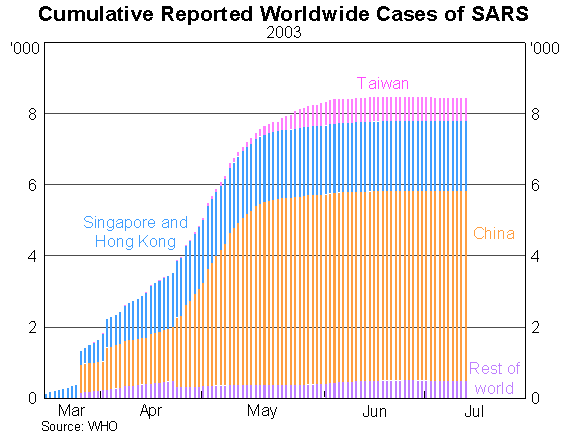
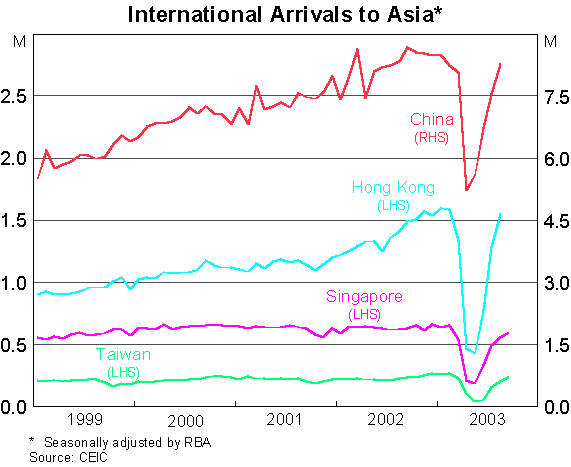
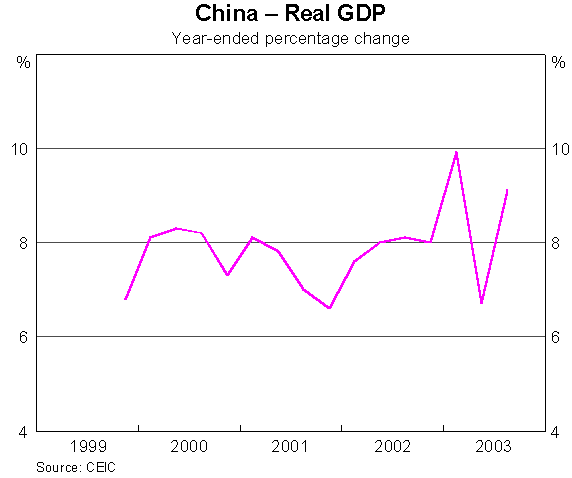
Let me turn now to a third important part of the world economy, namely Japan. I will cover this more briefly given that Japan has already been the subject of a separate presentation.
Overall, the Japanese economy has performed surprisingly strongly so far this year. Indeed, over the past year, Japanese GDP has increased by 3 per cent, which makes it the fastest growing economy in the G7, exceeding the US (Graph 10). This might seem a surprising result given the Japanese economy's consistent below-par performance over the last decade, and we might be tempted to ask whether this stronger recent result is some sort of statistical artefact. I don't think it is, or at least not entirely. While it's possible that the recent strength might be overstated, the general evidence of a cyclical upturn can be seen in a range of other indicators. For example, business confidence has improved, especially in the manufacturing sector, as has the level of profits. Business investment has picked up, and, according to surveys of investment intentions, is expected to strengthen further. We have also seen a modest decline in unemployment and an easing in the rate of deflation in consumer prices (Graph 11). All of these characteristics are consistent with a cyclical up-phase in the Japanese economy at present.
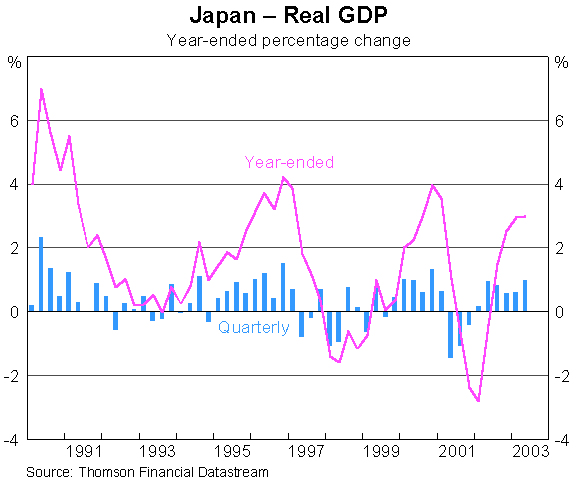
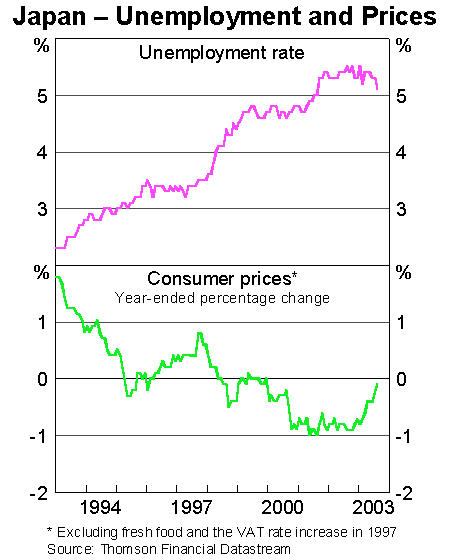
Having said that, I would not want to read too much into these trends in terms of their significance for the Japanese economy's longer-run challenges. The point I am making is that, while the pattern in Japan over the past decade has been one of disappointing growth on average, it does contain some cyclical variation around that trend. It is much too early to say whether the longer-term trend might be improving, but the recent data do, at least, indicate a cyclical upturn over the latest year.
The fourth region I should talk about briefly before drawing to a close is the Euro area. For the most part, the performance of the Euro area has been disappointing through the last year. Europe initially shared to some extent in the general pick-up in growth that was led by the US during 2002 (Graph 12). But the upturn in Europe was always less pronounced than in the US, and it was more heavily dependent on export growth rather than on domestic demand. Since late last year the pace of growth in Europe has eased markedly, to be close to zero as at the June quarter. More recent indications are that there has been some improvement in business confidence in the last few months, possibly reflecting the improving international climate (Graph 13). The IMF forecasts that I referred to earlier are for a pick-up in growth in Europe to around a 2 per cent pace next year. But, unlike the other main regions, there is not yet much in the way of hard numbers to show this is getting underway.
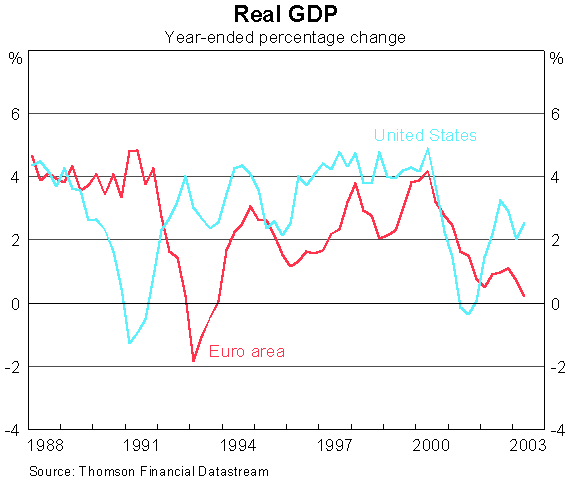
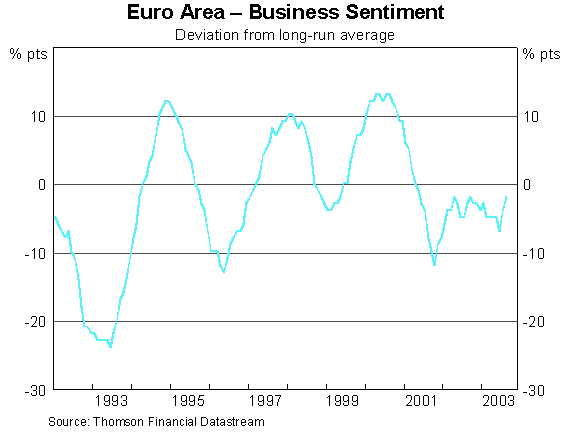
Concluding Comments
In summary, then, the recent economic data have been reasonably encouraging, at least in three out of the four economic regions of most importance to Australia. Obviously there are still some risks to the global outlook: the situation in Europe remains disappointing; the global recovery is still likely to be heavily dependent on growth in the US; and within the US, the sustainability of the recovery will depend on firmer outcomes emerging for employment and business investment.
Nevertheless, recent developments entitle us to be more confident about forecasts of ongoing recovery than was the case a few months ago. Some risks that loomed large in the first half of the year – the uncertainties about Iraq, the spike in oil prices, the SARS outbreak – have dropped away. And in the largest economy, the US, there are good indications that the expected pick-up in growth, long forecast for the second half of 2003, is now occurring.